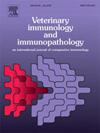通过被动免疫影响泽西犊牛传染性鼻气管炎反应水平的因素
IF 1.4
3区 农林科学
Q4 IMMUNOLOGY
引用次数: 0
摘要
传染性牛鼻气管炎(IBR)是由牛甲疱疹病毒1型(BoAHV1)引起的一种主要的病毒性疾病。初乳的被动免疫对保护新生小牛至关重要;然而,母源性抗体可能会干扰疫苗的效力,因此了解其动态以优化接种时间至关重要。本研究检测了55头泽西犊牛从出生到12周龄(接种前阶段)ibr特异性抗体的持久性,并分析了影响抗体水平的因素。采用多元线性回归分析方法,评价母犊品种、胎次、IBR反应性、妊娠期长、犊牛性别和初生体重对12周龄犊牛IBR反应性的影响。结果表明,泽西犊牛出生时IBR反应性较高,12周后逐渐下降。犊牛品种、胎次和产犊时IBR反应性显著影响12周龄犊牛IBR反应性水平(p <; 0.05)。犊牛初乳来自荷斯坦黑马、高胎次黑马或血清IBR反应性升高的黑马,12周龄时IBR反应性较高。这些发现强调了母体因素在形成被动免疫中的关键作用,并强调了进一步研究初乳质量和抗体吸收以改进疫苗接种策略的必要性。本文章由计算机程序翻译,如有差异,请以英文原文为准。
Factors influencing infectious bovine rhinotracheitis reactivity levels through passive immunization in Jersey calves
Infectious bovine rhinotracheitis (IBR), caused by bovine alphaherpesvirus 1 (BoAHV1), is a major viral disease affecting cattle worldwide. Passive immunity from colostrum is crucial for protecting neonatal calves; however, maternally derived antibodies can interfere with vaccine efficacy, making it vital to understand their dynamics to optimize vaccination timing. This study examined the persistence of IBR-specific antibodies in 55 Jersey calves from birth to 12 weeks of age (pre-vaccination stage) and analyzed factors influencing antibody levels. Multiple linear regression analyses were conducted to evaluate the effects of dam breed, parity, IBR reactivity, gestation length, calf sex, and birth weight on IBR reactivity in calves at 12 weeks. The results revealed that Jersey calves exhibited high IBR reactivity levels at birth, which gradually declined over the 12-week period. Dam breed, parity, and IBR reactivity at calving significantly influenced calf IBR reactivity levels at 12 weeks of age (p < 0.05). Calves that received colostrum from Holstein Friesian dams, higher-parity dams, or dams with elevated serum IBR reactivity exhibited higher IBR reactivity levels at 12 weeks of age. These findings highlight the critical role of maternal factors in shaping passive immunity and underscore the need for further research into colostrum quality and antibody absorption to improve vaccination strategies.
求助全文
通过发布文献求助,成功后即可免费获取论文全文。
去求助
来源期刊
CiteScore
3.40
自引率
5.60%
发文量
79
审稿时长
70 days
期刊介绍:
The journal reports basic, comparative and clinical immunology as they pertain to the animal species designated here: livestock, poultry, and fish species that are major food animals and companion animals such as cats, dogs, horses and camels, and wildlife species that act as reservoirs for food, companion or human infectious diseases, or as models for human disease.
Rodent models of infectious diseases that are of importance in the animal species indicated above,when the disease requires a level of containment that is not readily available for larger animal experimentation (ABSL3), will be considered. Papers on rabbits, lizards, guinea pigs, badgers, armadillos, elephants, antelope, and buffalo will be reviewed if the research advances our fundamental understanding of immunology, or if they act as a reservoir of infectious disease for the primary animal species designated above, or for humans. Manuscripts employing other species will be reviewed if justified as fitting into the categories above.
The following topics are appropriate: biology of cells and mechanisms of the immune system, immunochemistry, immunodeficiencies, immunodiagnosis, immunogenetics, immunopathology, immunology of infectious disease and tumors, immunoprophylaxis including vaccine development and delivery, immunological aspects of pregnancy including passive immunity, autoimmuity, neuroimmunology, and transplanatation immunology. Manuscripts that describe new genes and development of tools such as monoclonal antibodies are also of interest when part of a larger biological study. Studies employing extracts or constituents (plant extracts, feed additives or microbiome) must be sufficiently defined to be reproduced in other laboratories and also provide evidence for possible mechanisms and not simply show an effect on the immune system.

 求助内容:
求助内容: 应助结果提醒方式:
应助结果提醒方式:


